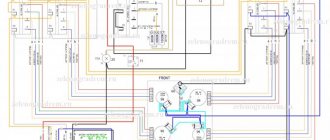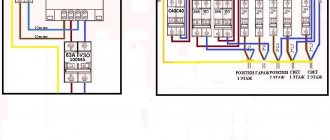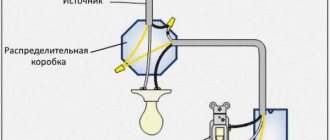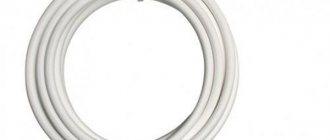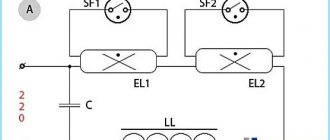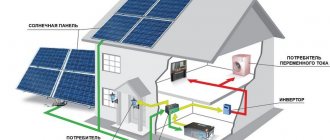In the heating systems market, film heated floors have already transformed from exotic types of heating into a popular, effective and fairly economical alternative to classical systems. The reason is simple - the emergence of modern film materials, which are relatively inexpensive and accessible, do not require serious capital expenditures when equipping the premises and are quickly installed, even independently with minimal work skills.
This article will be a detailed analysis of the features of infrared film heated floors made in Russia and South Korea.
Please note that here we are considering infrared heated floors as an additional source of heat in residential areas. If you are interested in installing a film heated floor as the main type of heating system, we recommend using a heated ceiling based on appropriate film materials. This is an order of magnitude more effective.
Types, design and principle of operation of infrared film floors
Most of the film materials used on the Russian market for organizing heated floors are of South Korean or domestic origin. This is due to several factors:
- uniform heating of the material over almost the entire area;
- convenient standard sizes: mainly roll deliveries 100 m long of various widths (500–1000 mm) with a cutting pitch of 200–250 mm;
- several types of power ranging from 110–400 W/sq.m;
- record quality guarantees (10–20 years of operation);
- optimal price accessible to most consumers.
The most famous manufacturers of infrared film materials are Q-Term , Heat Plus , RexVA , STEM Energy , Hit-Lite and several other companies. These are carbon-based electric heaters, supplied in coils, the operating features of which we will analyze.
Installation of a film heated floor includes laying a special film across which carbon heaters are located (see figure) having a linear shape.
These heaters have a strictly calculated resistivity. When an electric current passes here, electrical energy is converted into thermal energy, that is, the film heats up. The resulting heat is evenly distributed over the entire surface, quickly warming up the coating of your finished floor.
Current-carrying copper strips (busbars) are located on both edges of the roll. A variety of standard sizes and marking of cutting lines allows you to cut the film material directly on site with virtually no losses. In addition, thanks to its great flexibility, elasticity and minimal thickness (only 0.338 mm ), the material adheres perfectly to any surface, without requiring special preparation when installing a heated film floor. The weight of one “square” electric heater is 0.4 kg .
The main types of power of South Korean films: 150, 220, 300, 400 W/sq.m (less common options are also available). The width of the material most often has the following steps: 0.5, 0.8 and 1.0 m . All South Korean heaters have proven themselves to be excellent. The main thing is an accurate connection diagram for the film heated floor, high-quality installation in accordance with the instructions provided and proper operation. Many of these heaters are suitable not only for equipping heated floors, but also for heated ceilings (including as the main heat sources).
Among Russian manufacturers of infrared electric heaters, ZEBRA EVO-300 WF occupies a special place. This is an excellent development, which gained fame after the release of popular heaters for heated ceilings (ZEBRA EVO-300 series SOFT, ST, PRO, EX). EVO-300 WF was created specifically for heated floors. "Zebra" is a modular device, equipped with a grounding loop and a housing made of aluminum foil .
The main advantage of the Zebra WF is one-way thermal radiation , in which up to 95% of the energy goes directly to heating, providing record system efficiency.
An approximate connection diagram for the ZEBRA EVO-300 WF film heated floor is presented below. .
Advantages of film heated floors
There are many advantages of heated floors, here are just the most basic advantages that stand out to everyone who has installed film heated floors:
- Quick heating of the room. Direct impact on the floor material significantly increases the heating rate compared to the vast majority of alternative systems.
- Ease and simplicity of installation.
- There is no need to make a screed: the material fits perfectly under most types of finishing coating: laminate, linoleum or carpet.
- The room loses almost nothing in height (we remind you that the thickness of the electric heaters is only 0.388 mm).
- You can be completely calm, no water leaks will threaten you.
- The infrared system works completely unnoticeably and absolutely silently, everything happens automatically according to your settings.
- Control is carried out using a thermostat, which is equipped with a remote temperature sensor that responds to changes in parameters within 0.5 degrees.
The manufacturer guarantees the flawless functioning of the infrared heated floor for 10 to 20 years (depending on the specific company). The actual service life of electric heaters exceeds 25 years.
How to prepare the base
Before starting to prepare the base, determine the location for connecting the heated floor. A recess is made in the wall for the thermostat and wiring grooves. After this, the surface is thoroughly cleaned of debris and dust. It is especially necessary to ensure that there are no metal objects or other sharp irregularities left. Differences in floor height of no more than 0.3 cm are allowed. Such unevenness may occur at the junction of boards or reinforced concrete panels.
How to install a film heated floor if the unevenness is deep? You will have to make a thin cement screed, or make do with minor repairs of defects. In this case, you need to wait until the solution dries completely.
If the rough surface is cold (ground floor), it is covered with a heat insulator. In apartments above the ground floor this is not necessary. Sometimes it is necessary to start with laying polyethylene if there is a possibility that there will be dampness from below (for example, from the basement).
Typically, film manufacturers advise which thermal insulator is best to use. Its thickness should be at least 0.3 cm. This is important not only for better thermal insulation, but also so that you can subsequently carefully hide the protruding parts of the wire connections in the recesses made in the heat insulator.
Disadvantages of film heated floors
We do not idealize underfloor heating at all and objectively admit that it also has disadvantages. The disadvantages of such heating include:
- High heating costs for rooms with a very large area and high ceilings.
- Temperature restrictions. According to SanPiN (SNiP RF 41-01-2003 “Heating, ventilation and air conditioning”) the floor surface in rooms where people are constantly present should not heat up above 26 °C. And the floor temperature where people are temporarily located can be raised to 31 °C. Attempts to excessively raise the floor temperature (when the temperature outside is 30 °C or lower) will lead to discomfort: it will become too hot to walk on.
- Installation of film heated floors is possible only in open areas, free from furniture without legs. Otherwise, there is a risk of critical overheating of the film and its premature failure.
- The system dries the air. This occurs due to natural convection of air when heated. This is especially evident when using infrared heated floors as the main source of heating. In this case, we recommend installing humidifiers.
Specifics of film floor installation
Installation of film heated floors can be performed on a dry, clean base, where there are no strong differences in height or sharp objects. The subfloor does not require any special preparation. It is covered with one layer of thermal insulation material, and you can install an infrared floor. In a nutshell, the work is carried out as follows: a film and a temperature sensor are mounted on the floor, which are then connected to the electrical network through a thermostat. Before laying the finished floor, check the functionality of the structure.
An infrared heated floor must be covered with waterproofing material to protect against possible penetration of moisture. Ordinary polyethylene film can be used as a waterproofing material.
Energy consumption of film heated floors
To find out the maximum power consumption of the system, just pay attention to the labeling. For example, with a heater power of 220 W/sq.m for 1 hour of operation, 1 “square” of electric heated floor consumes 220 Wh (0.22 kWh) . Please note that the main energy consumption occurs when heating the room, and maintaining the set temperature requires periodic switching on, the frequency of which depends on the heat loss of the building envelope, as well as the parameters you set on the thermostat. Of course, the thermal insulation of the facility must be at least at the level of the SNiP recommendations of the relevant region.
The temperature sensor is located directly on the surface of the film material, under the finishing floor. Let's imagine that you set the thermostat to 26 °C, which is most comfortable for you. When this temperature value is reached, the sensor will record it, give a signal to the control device, and the thermostat will turn off the power. Then the floor will gradually cool down, and the speed of the process directly depends on the level of heat loss - and the thermostat will again supply power to the electric heaters.
Thus, the actual energy consumption at a particular facility directly depends on the frequency of system on/off . The greater the heat loss, the higher the consumption . We recommend that the floor be insulated (a layer of conventional building insulation 100 mm thick is sufficient). In this case, the specific average electricity consumption will be about 20–30 W per 1 sq.m of heated area.
The most common mistake made by buyers of electric heated floors is that they want to use them to insulate their floor. But the film material does not retain heat: its task is to generate thermal energy . And the resulting heat must be retained by special insulation materials , which must be included in the floor design. The modern market offers a lot of available options for insulation from various companies from different materials (Knauff, Isoverr, expanded polystyrene, etc.) with a thickness of 30 to 100 mm (the thickness is selected depending on the climatic characteristics of the region and the design of the insulation object).
What happens if the installation of a film heated floor is carried out without insulation? In some cases, the system can cope with heating your room, but in most cases it cannot. Without insulation, thermal energy will simply be lost, escaping into the atmosphere, into the ground, or absorbed by ceilings. But in any case, excessive consumption of electricity is inevitable, because the system will have to work almost constantly to compensate for heat loss.
Is it possible to use special substrates up to 5 mm thick, since they also reduce thermal conductivity? Yes, such a substrate is better than nothing at all. However, the effectiveness of insulation is manifested with a minimum thickness of insulation material in the floor structure of 100 mm.
Technical characteristics of heating film
Before purchasing a film floor, it is recommended to carefully study the models offered on the market in order to choose the best option in terms of quality and cost. To do this, you need to understand the differences and technical parameters of the different options.
When purchasing thermal film, it is advisable to pay attention to the following characteristics:
- power - always indicated per linear meter. Generally, 44-68 W is a suitable value;
- melting temperature - 130 degrees is indicated, but during operation it should not rise above 55 degrees Celsius;
- percentage of IR radiation in the total frequency spectrum – a value above 95% is recommended;
- material thickness – the most common thickness is 0.4 mm;
- the length and width of the film sheet is in most cases 8 x 0.5 m. Determined based on the area of the room.
Calculation of film heated floors
For the efficiency of an infrared heated floor, a correct preliminary calculation of its power is important. Let's give an example in which a heated floor is planned to be used as an additional heat source (that is, a boiler or central heating operates in parallel). In this case, it is enough to cover up to 50% of the floor with film.
To begin with, we determine the useful heating area. The usable area is only its open areas, not occupied by furniture, etc. The picture of the room below shows that the usable heating area is 8.6 sq.m (S = 4.1 x 2.1 m).
Based on the size of the usable area, we select the standard sizes and number of film electric heaters, while it is desirable to cover the entire usable area to the maximum. Here we will use South Korean film with a power of 150 W/sq.m with a width of 500 mm . You will get 4 sections of 4 meters each, that is, 8 sq.m of electric heaters with a total power of 1.2 kW (8 sq.m x 150 W/sq.m = 1200 W). We get a load current of 5.5 A (1200 W / 220 V = 5.5 A).
We recommend drawing up a laying diagram before installation. On it you will need to mark the location of laying the film sections, the distance between the strips, the connection diagram for the film heated floor, including the location of the power wires and the temperature sensor coming from the thermostat.
Note! It is strictly forbidden to lay electric heaters overlapping! There should be 10–20 cm . 50 mm is allowed between the heater strips .
Another very important point. At the site where it is planned to install film heated floors , there must be additional electrical power . Quite often, in its absence and high energy consumption (the system operates in several rooms simultaneously, including as the main one), the problem of network overload . This leads to constant operation of the input machine and other troubles.
In order to avoid such problems in the future, it is necessary to design the power supply parameters of the facility in connection with the additional electrical power of the heated floor.
Below we present the recommended maximum length of South Korean carbon-based film materials depending on the width of the roll and the specific power of the heater.
| Table No. 1. Recommended maximum length of South Korean carbon-based film materials depending on the width of the roll and the specific power of the heater. | |||
| Roll width (m) | Specific power (W/sq.m) | Recommended max film length (m) | |
| 0,5 | 150 | 10 | |
| 0,5 | 220 | 8 | |
| 0,8 | 220 | 6 | |
| 1,0 | 150 | 7 | |
| 1,0 | 220 | 5 | |
Impact on the environment and the human body
The properties of film floors have not yet been fully studied, since they began to be used relatively recently. In this regard, the most contradictory judgments arise regarding these systems. There is an opinion about the beneficial effects of infrared radiation on the human body. Allegedly, it is completely harmless and serves as an effective means for the prevention of many diseases.
However, both supporters and opponents of film floors are wrong. The fact is that the emitted electromagnetic waves have extremely low intensity and do not have any negative effect on humans. Much greater radiation is emitted by heated cable floors used under tiles and with other coatings. However, it is considered completely safe and harmless to health.
With such a low level of radiation, film floors do not have a positive effect on the human body. The positive influence of electromagnetic fields is possible only when the temperatures of the human body and the infrared wave coincide. This state is almost impossible to achieve at home. The uniform heat of a heated room and optimal air humidity are considered more beneficial.
There is a misconception that it is impossible to use an infrared floor in conjunction with laminate or linoleum, which prevents the passage of radiation. Indeed, the rays from the film do not pass through such a floor barrier, but in this case they themselves heat up first, and only then the heat from them enters the room. If other types of flooring are used, the heat directly warms the air and spreads immediately to the entire height.
Selecting the cross-section of the electrical cable for film heated floors
The choice of electrical cable cross-section for film heated floors is made depending on the area of the materials used and, accordingly, the power of individual groups of film heaters . These recommendations are compiled taking into account the electrical installation rules (ELI), as well as taking into account the underestimated wire cross-section data of some manufacturers. So, a wire marked 2.5 sq.mm actually turns out to have a cross-section of 2–2.1 sq.mm. Below is a table with the recommended cross-section of copper wire, depending on the maximum area of the heaters and the power of one group.
| Table No. 2. Selection of electrical cable cross-section for film heated floors | |||
| Film heater power (W/sq.m) | Cross-section of copper wire (sq.mm) | Recommended maximum area of film heaters of one group (sq.m) | |
| 150 | 1,5 | up to 12 | |
| 150 | 2,5 | from 12 to 20 | |
| 150 | 4,0 | from 20 to 30 | |
| 220 | 1,5 | up to 8 | |
| 220 | 2,5 | from 8 to 14 | |
| 220 | 4,0 | from 14 to 24 | |
If the area of the group heaters exceeds the values indicated in the table, then when connecting they must be divided into subgroups of permissible area in accordance with the recommendations. Example: 28 sq.m of infrared heated floor with a power of 150 W/sq.m can be easily divided into 2 subgroups of 14 “squares”. In this case, each subgroup is connected to the power line with a separate wire with a cross-section of 2.5 sq. mm.
Note! The choice of power wire cross-section for connecting an electric heated floor is very important. If you install wires with a reduced cross-section (relative to the recommended one), this risks overheating the wire, melting the insulating layer, which can lead to a fire!
Consequences of possible mistakes when laying the floor
Often home craftsmen make mistakes and mistakes when installing a film floor system. Most often, during installation, craftsmen forget to correctly connect the strips of warm film to each other. This connection is performed strictly in parallel. If you use a series circuit, the heating will not be efficient enough. And with some more serious errors, it even threatens to cause a short circuit.
Cutting film elements is permissible only in those areas marked by the manufacturer. If by mistake the film is cut in another place, a break will occur in the electrical circuit, in which case the floor will no longer heat up properly.
Another mistake may be associated with insufficient cleaning of the underlying surface, which can cause mechanical rupture of the tape in places where it comes into contact with debris, nails and other unnecessary elements. Also, the film can fray in places where there were strong differences in heights, holes or bulges. If the tape is damaged, it causes the heating of a certain area of the floor or the entire system to turn off.
It is very important to connect the heated floor using a special differential machine to turn the system off and on. This solution will guarantee timely shutdown of power supply due to voltage surges, short circuits or open circuits. The absence of such a switch can cause a fire and electric shock to household members.
Composition of the “pie”
And another very common mistake is incorrect placement of the temperature sensor. If the part of the floor under which the sensor is located has additional cooling, for example, due to its proximity to the front door, or is heated when located next to radiators, then temperature regulation will be incorrect. As a result, the sensor will increase or decrease the heating temperature for no reason.
Thermostats for film heated floors
The thermostat is the control device, or simply the brain of the film heating system. It is this that allows you to automatically control and manage the heating process, maintaining a preset temperature. The main difference between thermostats for heated floors is the presence of a remote temperature sensor , which is located on the surface of the film, immediately under the final finishing of the floor.
We constantly monitor the equipment market, selecting thermostats for our clients that can definitely be trusted to control film heated floors. Such devices include 70.26, E 31.116, E 51.716, E 91.716, Wi-Fi SIU WF-1 and some others. You can freely find a description of the advantages and connection diagram for each device on our website.
Stage 4
Protection of with bitumen insulation . One strip of film requires 5 pieces - two for the contacts with terminals and one for the non-contact side. If you purchase a ready-made heated floor kit (KEEPLY), then the non-contact side of the strip will already be insulated on the heating film. The insulation of the non-contact side of the other strips is made according to the sample. When purchasing cut-to-length IR film, please note that in additional VF kits, bitumen insulation is included with terminals.
Insulation of the contact terminal with two bitumen pieces
Dividing one piece of bitumen into two parts
The process of insulating the non-contact side with half a piece of bitumen
To connect two strips of film you will need a VF2 kit, which includes 10 pieces of bitumen insulation, for three strips - VF3 with 15 pieces, for four or more strips of film - VF4 and VF5 with 20 and 25 pieces, respectively.
Accessories and tools for film heated floors
This includes almost everything that can be included in the system, from the substrate to the machines, tape and connecting contacts to the tools that will be needed during installation. Let's look at the required components using the same example used above. So, the useful heating area is 8.6 sq.m, there are 4 pieces of film, the total power of the heaters is 1.2 kW. Based on this data, we will select additional materials and equipment:
- Substrate for heaters. Isolon with a thickness of up to 5 mm and an area of 10 sq.m. is ideal here. This provides additional thermal insulation and protects the film from accidental damage on the base of the floor. Attention! The substrate must be without metal coating (aluminum foil).
- Polyethylene. Performs a protective function against accidental water leaks. 10 m² of polyethylene with a thickness of 50 microns is sufficient.
- 10 A circuit breaker – 1 pc.
- Modular box (for 4 modules).
- PuGV wire 1 x 1.5 sq. mm – 2 pieces of red and blue, 10 linear meters each.
- Connecting clamps (clips) – 2 pcs. for each heater + spare pair, 10 pcs. in total.
- Bituminous tape for insulating the ends of films (at the rate of 30 pieces of 50 x 50 mm: 6 for each electric heater plus a small reserve).
- Household (ordinary) tape for fixing materials.
Installation tools: screwdriver, wire cutters, pliers, assembly knife, scissors, electrical tester.
Features of connecting electric heating
When connecting the thermostat to the network, a circuit breaker specially designed for this purpose is activated. The floor covering, regardless of type, becomes a heat accumulator and increases the temperature of the heating elements by an additional degree.
Ease of installation.
They can be mechanical or intelligent, controlling indicators of the environment and the floor itself.
Temperature restrictions. It is needed to reduce the temperature of the carrier when overheated; installation of separate boxes for each room, if adjustment is needed in individual rooms.
Penofol is suitable, which is used when laying laminate or insulating pipes. Connection diagram of a thermostat sensor to a heated floor The principle of connecting all elements of the system to the thermostat and the electrical network is the same. The installation diagram of this device is quite simple. They can be mechanical or intelligent, controlling indicators of the environment and the floor itself. Connecting an electric heated floor mat to a thermostat from GRAND MEYER.
Connection diagram for film heated floor
The film heated floor operates from a standard network of 220 V , 50 Hz . Connecting films to the network is parallel . A schematic diagram of connecting a film heated floor (again, we focus on our example) is presented below.
- Design group load data.
- 10 A circuit breaker.
- Thermostat RTC 70.26.
- Group wires PuGV 1 x 1.5 sq. mm.
- Insulation of the connection point of the group wire to the film.
- Insulation of current-carrying copper bars at the ends of the strip.
- Remote temperature sensor.
Thermal reflective insulation
| Manufacturer: | HEATED FLOOR chain store |
| Length: | 1m |
| Equipment: | per cut |
| Thickness: | 4 mm |
| Width: | 1m |
for comparison
177 rub.
Product added to cart
| Photo | Name | Price per piece | Quantity | Price |
| Thermal reflective insulation | 177 rub. | < 1 > | RUB 177,177 |
There are 0 items in the cart worth 0 rub.
Go to cart
Buy
Availability

